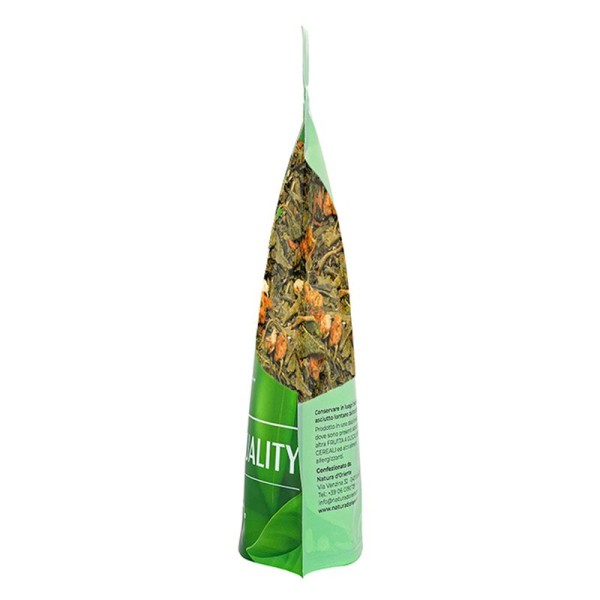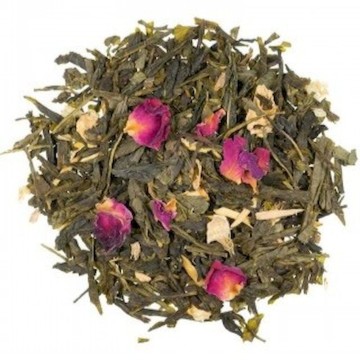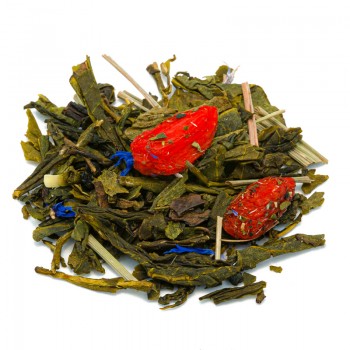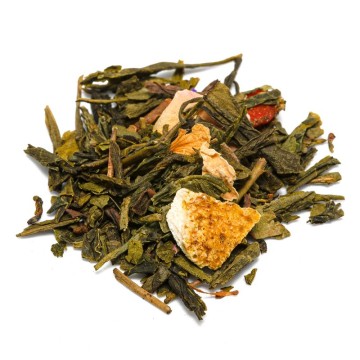To give the palate a soft taste and stimulate sweet scents, this green tea becomes tasty, enveloping in the exotic notes of cinnamon and vanilla. Thanks to ingredients such as orange peel and apple, it also offers a refreshing aftertaste, while rose petals provide a delicate aroma. Perfect for the colder months, it can be pleasantly surprised even in summer. This green tea is not only inviting, but also promises well-being; typical of Sencha green tea and enhanced by other ingredients.
Properties and benefits
In addition to the pleasant and unique flavor, the qualities of this Sencha help well-being in various ways. A green tea with vanilla and cinnamon has various antioxidant properties, the so-called anti-aging qualities that counteract the damage of free radicals. Especially in the green tea version, the antioxidants and plant compounds are taken correctly. Vanilla is also known for its antioxidant properties, thanks to the vanillin compound which fights free radicals and promotes well-being in digestion. Furthermore, its exotic scent promotes psycho-physical relaxation and stimulates the senses (vanilla was considered an aphrodisiac spice in ancient times). An effect enhanced by the intense aroma of cinnamon, which also contains various nutrients useful for the digestive system through tannins and pectins, as well as from the apple. The properties of cinnamon can make green tea a tonic against psycho-physical stress, an ally in case of fatigue, also to promote attention and concentration. From the point of view of purification and to slim down, we remind you that including green tea in the diet can help speed up the metabolism, regulate blood sugar, and burn fat better. Sencha's antioxidant compounds facilitate a correct fat assimilation metabolism. Furthermore, green tea with cinnamon is an excellent drainer, promoting diuresis and the expulsion of excess liquids from the body. The addition of the vanilla and cinnamon flavor allows you to appreciate this drink, stimulating the sense of fullness. Cinnamon favors the disappearance of the "nervous" appetite, i.e. not real but perceived only for satisfaction. Orange peel also satisfies the palate by helping to reduce appetite. The orange peel, in addition, provides the body with vitamin C and contains substances useful for proper digestion. A vanilla and cinnamon green tea is also invaluable during colds and flu syndromes, as an infusion suitable for hot drinking. It also finds a great response cold prepared for summer and spring, thanks to the notes of ingredients such as apple and rose petals.
Origins and History of cultivation
Sencha tea comes from the Camellia Sinensis plant, but differs from other teas in terms of cultivation and processing, which give a particular green tea. Sencha leaves are traditionally grown in Japan in direct sunlight. They are chosen from the first and second harvest, among the youngest and highest quality shoots. The historical preparation of Sencha green tea involves steaming the whole leaves for less than a minute, in order to avoid oxidation. They are then rolled up and dried. This process makes Sencha a golden green tea with a sweet and refreshing aroma. Tea is widespread in Japan, where it was introduced by visiting Chinese Buddhist monks, but the Sencha process came later, when it was decided not to grind the leaves anymore, as was initially done in Matcha.
Preciated by samurai elites and feudal nobles, it has been part of the Japanese tea ceremony for centuries. Over time, it spread to all strata of the population, and today Sencha is the most loved in the Rising Sun. It is used not only as a direct infusion, but also as a base for herbal teas, for cooking and as an ingredient in cosmetics. Different varieties of Sencha green tea are grown, or not, known for their different flavors. From spring tea varieties, from the first harvest, to those grown partially in the shade for several days. To this basic ingredient, the tea combines vanilla and cinnamon, which have a different story. Vanilla comes from the pods of an orchid, native to Mexico (or the northernmost areas of South America). The scent comes from the pods, after having undergone a precise manufacturing process. The pods are left to develop for about 9 months, then harvested and subjected to various methods to obtain the desired aromatic nuances.
The plant has been known to indigenous people for centuries, used dto the native Aztecs to flavor the xocoatl, the chocolate drink. Explorers gave it the Spanish name vania, which means pod, and illa which is the suffix for "small", and the aroma of the pods was very successful when it was exported to Europe. Today it is used to flavor food and drinks, chocolate, sweets and ice cream, and in perfumery. The first cultivation of vanilla for industrial purposes occurred in the Veracruz area. Cinnamon is one of the oldest spices in the world, coming from the Indian subcontinent, from the island of Ceylon (Sri Lanka).
Known as true cinnamon, today it grows in much of South and Southeast Asia, Madagascar and the Seychelles Islands. It was discovered by making it from the inner part of the bark of the cinnamon tree, which was dried. In the drying process, the bark curls up creating the cinnamon stick – which will be ground into a powder in the case of ground cinnamon. It has been used for thousands of years, known as early as 3000 BC. as a perfume for embalming among the ancient Egyptians. It was brought to Europe by Arab traders, and soon became popular with the Greeks and Romans for its ability to preserve meat over the winter. Furthermore, medicinal properties were attributed to it.
Plant and flowers
Tea comes from the leaves of the Camellia Sinensis plant (also called Thea sinensis), native to East Asia. This genus includes about 250 species of evergreen trees and shrubs, all belonging to the Theaceae family. Camellia sinensis can reach 9 meters in height, but is usually grown small to a low bush of about 1 meter, for ease of cultivation and harvesting. It is pruned frequently to encourage tea leaf development, with harvested shoots of different stages. Shows white or yellow fragrant flowers.
Vanilla, on the other hand, derives from Vanilla planifolia - the most important of the 110 species of plants in the genus Vanilla, part of the Orchidaceae family. that all species are derived from a single native of Central America. These plants show a climbing stem and roots that penetrate the ground. The numerous flowers vary from creamy white to pale green, open in turns and last only one day. The flowering season lasts about two months, while the fruit ripens in 4-6 weeks (it can take up to 9 months). It is a long capsule, and its unripe pods are harvested when they turn golden at the base. The vanilla pods from which to extract seeds and aroma derive from 3 types of orchids of the vanilla genus. We also know Vanilla x-tahitensis, a Polynesian species with limited cultivation and Vanilla pompona, grown in the West Indies.
The botanical name of the cinnamon tree is Cinnamomum zeylanicum. It is an evergreen tree of the Lauraceae family, and its bark is famous for its aromatic properties. The cinnamon tree grows in moist, well-drained soil, reaching about 15 meters in height. The leaves are oval and the small flowers are greenish or yellow, while the fruit is a dark drupe. To obtain the spice, other species similar to Ceylon cinnamon are also cultivated: Chinese cassia (Cinnamomum cassia), Vietnamese cinnamon (C. loureiroi), Indonesian cinnamon (C. burmannii), and Malabar cinnamon (C. citriodorum).
Nutritional values of vanilla green tea and cinnamon
Green tea has beneficial components such as antioxidant catechins, tannins, flavonoids. Gives the body caffeine, as a stimulant of the central nervous system, and Theanine. It makes available the antioxidant and immune system stimulating vitamin C, and other vitamins of Group B. From other useful substances such as some minerals (fluorine, zinc, manganese, copper, selenium), also present in vanilla. Cinnamon adds the compound cinnamaldehyde which gives cinnamon its sweet, spicy scent. It is rich in other polyphenols and tannins, minerals such as manganese and iron, and is a source of vitamins A,C,K.
How to prepare vanilla and cinnamon green tea
The infusion is obtained by placing in a cup (250 ml), about 3-5 grams of this green tea. Water at a temperature of 80 °C. Leave to infuse for 2 to 3 minutes, before drinking the flavored green tea infusion.
Green tea vanilla and cinnamon: side effects and contraindications
Consumption of green tea is safe for most people, avoiding excessive quantities. Exaggerated consumption can cause side effects due to the caffeine content, particularly in sensitive individuals. Symptoms such as headache, agitation, irregular heartbeat, difficulty sleeping, diarrhea, hypertension may occur. Furthermore, excessive doses can disturb the digestive system through intestinal irritation, due to tannins and caffeine (especially on an empty stomach). Green tea should be taken with caution by those suffering from anemia, high blood pressure and pathological heart conditions. The vanilla component could cause headaches and excessive sleepiness, while cinnamon in large quantities could cause burning sensation or itching in the oral cavity. Caution is advised when taking green tea during pregnancy and breastfeeding.









 No reward points for this product.
No reward points for this product.
![green tea hemp mango [Natura d'Oriente]](https://www.naturadoriente.com/3381-home_default/green-tea-mango.jpg)




![Green Tea Sencha Kombucha [Natura d'Oriente]](https://www.naturadoriente.com/3380-home_default/-green-tea-sencha-kombucha-.jpg)


![Green Tea Choui Fong Tea [Natura d'Oriente]](https://www.naturadoriente.com/3379-home_default/green-tea-choui-fong-tea.jpg)




![Green tea Jasmine and jasmine [Natura d'Oriente]](https://www.naturadoriente.com/3373-home_default/green-tea-jasmine-and-jasmine-.jpg)

